Abstract
Almost always when it comes to the end of a trip, to rethink and remember the places visited, the first memo to emerge is that chromatic. Certainly many other factors populate memories, such as climate, mood, company, health, etc., but light and color are the elements that most strongly identify spaces and selects them according to “favorable” or “unfavorable” perceptions, unconsciously privileging a “chromatic territory” over others, characterized by the effects it produces or by the simple aesthetic value, where shapes, light and colors have nicely marked the journey. The author also wants to propose; through a series of sketches and drawings; a sequence of color images made by the author on a journey of more than 6000 km; between the major North American metropolises in New York; Washington; Chicago; Boston; Philadelphia; Buffalo; Cleveland; etc.; and the small centers that together represent a genuine universe of colors whose properties manifest themselves physically; perceptively; and physiologically.
1. Introduction
Almost always when it comes to the end of a journey, to rethink and to remember the places visited, the first mnemonic trace to emerge is that chromatic. Of course many other factors populate memories, such as climate (rain or sun, hot or cold), mood, company, health, etc., but light and color are the elements that most strongly identify spaces and select them according to “favorable” or “unfavorable” perceptions, unconsciously privileging a “chromatic territory” over others, characterized by the effects it produces (comfort, oppression, closure, barrier) or by the simple aesthetic value, where shapes, light and colors have nicely marked the journey.
An “on the road” trip undertaken in 2011 in the eastern United States by touching the major metropolises in the United States, Boston, Philadelphia, New York, Washington, Chicago, has left in particular vivid memories linked to different chromaticities such as architectural fabric and historical, touristic and sometimes high-tech advertising lights. The recorded color shades produced by streets and architectural buildings, vegetation and means of transport, as well as the urban furnishing elements (insignia, billboards, etc.) are an integral part of the urban scene and contribute to qualifying it best or worse, sometimes overlapping the shape of the single architectural element or building fabric in general, guided by its expressiveness, exalting its functionality, and, when necessary, attenuating its degradation.
The contribution also traces, through the testimony of some photographic shots, the chromatic path of that journey: from the multiethnic and multicolored New York to the gray-white shades of the tombs of the Arlington cemetery, the Lincoln statue and the various memorials and monumental buildings of the city of Washington DC; from the red bricks line that marks the path of the Freedom Trail on the sidewalks and on the streets of Boston, to the multicolored Street Art of Philadelphia murales.
2. Philadelphia and the Street Art of Its Murals
In Philadelphia, each wall has become a potential white canvas since in 1984 an anti-graffiti campaign to combat the degradation that damaged some areas of the city, kicked off the Mural Arts (in 1984, Philadelphia’s then Mayor, Wilson Goode, established, in collaboration with some artists, the Mural Arts Program, a program that encourages aspiring artists to leave the mark on the city) program, which in more than 30 years produced about 3600 murals by earning Philadelphia the name of “City of Murals” (Figure 1). The murals have added color, beauty and life to an industrial city that for decades has been facing an economic and demographic crisis; mixing the history of places with street art, transforming public spaces, often incredibly, vast areas of the city have been valued.
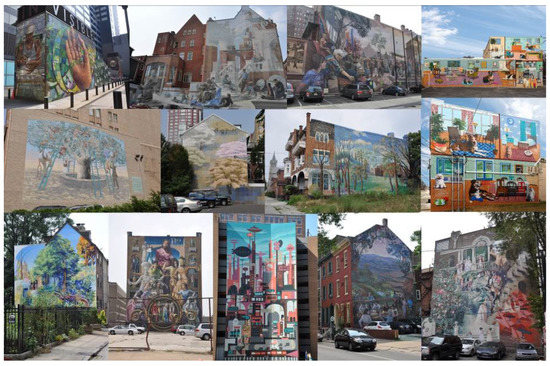
Figure 1.
Some images of murals made in Philadelphia under the “Mural Arts” program.
The project has allowed authors to take an active role in enveloping neighborhoods and communities as they are all involved in creating works: it is the people in the neighborhood who choose the wall to paint and process the subject together with the artist, thus adding their contribution in the realization process.
These murals denote a high degree of artistry and a high social and political content mixing traditional American culture and topical news topics, sometimes narrating salient pieces of community history.
To name a few: the mural “Forever Home”, produced in 2014 by the artists Kala Hagopian and Ali Williams, known as Chroma Dolls, to promote the campaign pro-homeless animals Philadelphia) depicting animals that once lived in the street or in shelters and now have loving families. Murals were possible thanks to the generous support of families, many of whom are supporters of the Philadelphia Animal Welfare Society (PAWS) and volunteers. They were made at the new PAWS clinic and adoption center, located in the northeastern part of Philadelphia; the “Civic Engagement” portraits (made by students Keir Johnston & Mural Corps Students in 2009) of people who devoted their lives to improving society, struggling for major social causes (African environmental activist Wangari Maathai, American journalist Marjory Stoneman Douglas, Mexican trade union leader Cesar Chavez, guatemalan Rigoberta Menchu, Indian writer Jiddu Krishnamurti, Mexican painter Diego Rivera); the mural “The color of your voice” (made in collaboration between Murals Arts, Project Home, the Hank Gathers Rec Center and the Department of Behavioral Health and Intellectual Disability between October 2011 and May 2012); the largest gemstone wall in the world, “Pride & Progress” gay (located in the heart of the gay community in Philadelphia, between S. Juniper Street & Spruce Street, Ann Northrup), telling the progress of the movement for the rights of American gay, born in Philadelphia in 1960.
An example of this is the series of murals made by artist Phillip Adams (Figure 2), which are part of a visual narration of the key sectors of the industrial history of the city, such as beer production, textiles, tool making, railways, etc. The first two works of the Industrious Light series are representative of the history of beer. The first mural in this series, the work of Ortlieb Brewery, was installed in the fall of 2014, approximately one year after the brewing of the brewery.

Figure 2.
Two of the murals made by Phillip Adams in Philadelphia.
The mural presents the tools for brewing beer. The second work of the series, located at the former Weisbrod & Hess Oriental Brewing Company and the current headquarters of the Philadelphia Brewing Company (PBC), wraps up the facade of Rowhouse Spirits, a recently opened distillery, and depicts the relationship between beer and distillation through the representation of industrial materials.
In the second half of the 20th century, the manufacturing economy of the city of Philadelphia, known as the “workshop of the world”, experienced an inexorable decline, leaving behind enormous and often magnificent “physical remains”, including mills and factories, now forgotten or underutilized.
The project involves the creation of mostly murals, a return to the black and white perception of the historic city, as well as a reference to the raw materials of the industrial era. Worth to mention is also the project “A place to call home” (the project sponsored by the “Place to Call Home” Association for Homeland and Health Care for Children in Philadelphia was completed on 25 June 2011—Figure 3), for the realization of which a whole block of Homes of Melon Street (38th & 39th Street) in the western Philadelphia area has been deeply transformed from artists, teenagers and the same owners of homes that colored the exterior in a geometric mesh designed by muralist Ernel Martinez.
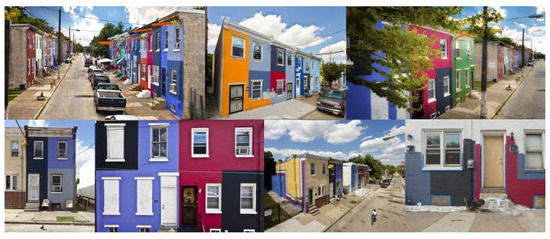
Figure 3.
Pictures of the facades of houses that have been the subject of the project “A place to call home” in the city of Philadelphia.
In this way, each building is part of a single identity, such as the canvas of an abstract painting; the over 30 facades represent a visual and physical path leading to 3828 Melon Street, an abandoned property that has been reclaimed and transformed into a “home of art” to host multimedia installations on the theme of “home”.
Paul Santoleri represented “the frenzy and vivacity of the city of Philadelphia” in a mural built on the side of a refinery tank located on the road from the airport to the center of the city. The design is a “caricature” representation of the city’s architecture (Figure 4).
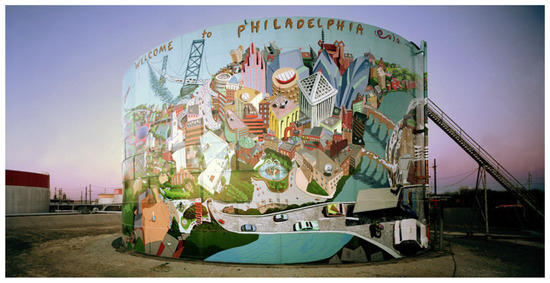
Figure 4.
Image of the wall made by Paul Santoleri representing “the frenzy and vivacity of the city of Philadelphia” on the side of a refinery tank.
Among the many artistic examples produced by the Mural Arts program, it is worth mentioning the Dutch urban sculpture by Jeroen Koolhaas and Dre Urhahn, also known with the Haas & Hahn nickname, which in 2010 revolutionized the fifth visual of the historic Germantown Avenue (“the Avenue”) north of Philadelphia (Figure 5). The project, named Philly Painting, affected the façades of 51 showcases that were painted in a palette of over 50 colors reflecting the typically rich and complex character of the neighborhood.
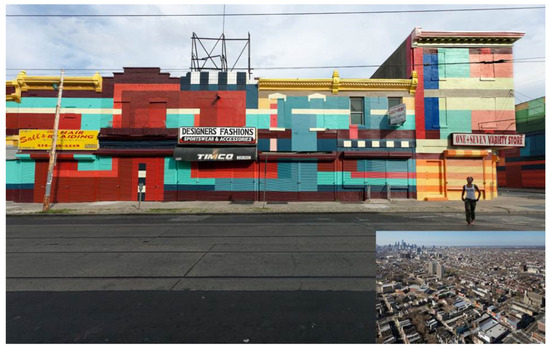
Figure 5.
Picture of the mural created by Jeroen Koolhaas and Dre Urhahn for the project called Philly Painting.
3. The Gray-White Shades of the Historic City of Washington
The gray-white shades of the many neoclassical and neo-Renaissance buildings and monuments of the second half of the 19th century, stand out among the green planes of city parks, giving the historic fabric of Washington City a unique and homogenous face. The white color of the sandstone, together with the marble from the various state and granite quarries, is the undisputed protagonist. First of all, the White House, the presidential residence built on the 16th century paintings of Andrea Palladio, whose white sandstone gives the Palazzo the imposing importance of its function, and the Capitol (US Capitol), headquarters of the United States Congress, known for its majestic white-colored architecture (sandstone and marble) from the top of Capitol Hill dominating the entire Mall area. In front of it are the Palace of the Supreme Court (built in neoclassical style, and exterior facades have been made of Vermont marble, while those of Georgian marble interior courtyards, most interior spaces are lined with Alabama marbles) and the Library of Congress (1800), the largest library in the world, also with exterior facades covered with marble. In this same area there are the main federal buildings as well as the most important memorials whose coatings range from the white sandstone to the gray shades of iron and granite. Among these are the 56 granite pillars of the National World War II Memorial and the Polished Black Granite Trapezoidal Walls of the Vietnam Veterans Memorial, the exterior walls and columns in the historic white marble Danby Imperial of the Thomas Jefferson Memorial (a variety of marble from the Vermont quarry, while the inner areas, paved with pink Tennessee marble, are covered with white marble from Georgia; ceiling was built in Indian granite); Indiana granite and Yule marble from Lincoln Memorial (it is a monument built in honor of Abraham Lincoln, the sixth president of the United States, and rises in the National Mall of Washington DC. The building is made of Granite of Indiana and marble of Yule, coming from the Marble quarries in Colorado. The statue of Lincoln inside is made of Georgian marble (1922) from the Tate quarries in Georgia) the marble, granite and sandstone blocks of the Washington Monument (1884—the Washington Monument is a marble obelisk, erected in Washington DC to commemorate George Washington, founding father and first president of the United States of America. It was made up of blocks of marble, granite and sandstone designed by American architect Robert Mills in the forties of the nineteenth century), an obelisk of about 170 m high; and finally the 19 stainless steel statues of the Korean Veterans Memorial. The Korea War memorial is located near the Lincoln Memorial on the National Mall in Washington, DC. The monument recalls the sacrifices of the 5.8 million Americans who served in the US armed forces during the three-year period of the Korean War. The memorial is made up of a series of statues of soldiers placed in juniper bushes and separated from polished granite strips, giving a semblance of order and symbolizing Korea’s rice paddies (Figure 6). The color uniformity of the Washington city landscape finds more confirmation in the white crosses of the Arlington National Cemetery tombs as well as in the concrete cladding ceilings of underground subway stations [1].
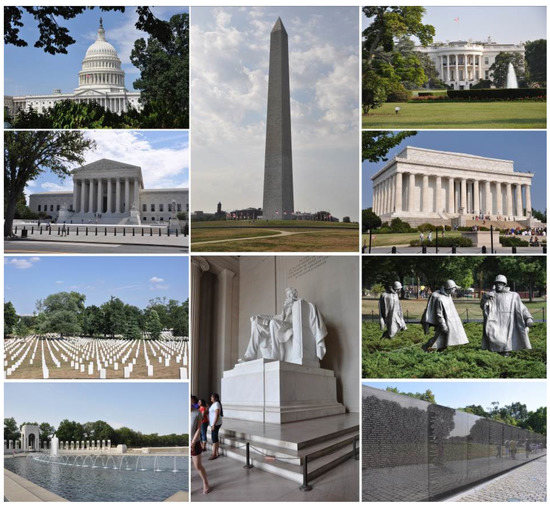
Figure 6.
Pictures of some monuments and historic buildings in Washington: the Capitol, the White House, the Supreme Court, Washington, Lincoln, World War II, the War of Korea and Vietnam, the Cemetary of Arlington.
4. Frank Lloyd Wright’s Architectural Chromatic Materials in the Oak Park and River Forest Districts (Chicago)
In the first twenty years of his career, Frank Lloyd Wright designed and built architectures whose style became unmistakable: the Prairie Houses, many of which can still be admired by walking through the Oak Park and River Forest residential districts, in the western suburbs of Chicago. The diversified richness of the materials used, as a formal translation of architect’s design choices, originates chromatic patterns that make them unique in their genre and suggests a figurative language that is in direct harmony with the senses, preferring chromatically hot materials and autumn colors such as red, gold, brown, yellow and green: for example, the front entry of Chauncey Williams House (1895), flanked by stones from Des Plaines River, or the horizontal slats of the slates of the facade of Harry C .Goodrich House (1896), which favors a gradual transition from shades of darker to lighter shades. The attention to the chromatic aspects is witnessed also from other juvenile buildings such as Francis J.Woolley House (1893), Thomas H. Gale House (1892), and Walter Gale House (1893), in which the shades of green are persistently applied. In 1894, Wright built in River Forest what would then be considered a real anticipation of the style of the Prairie Houses: the William H. Winslow House. The façade is characterized by the different chromatic shades of the light brick flooring elements of the ground floor and the dark terracotta of the second floor. Another example is that of Arthur B. Heurtley House (1902), whose bow of the fireplace re-exposes that of the entrances covered with Roman bricks instead of the standard ones used for the exterior facade. In the chromatic palette of the architect, a particular role is covered by the windows, made up of lead glasses decorated with geometric motifs and stylized representations of natural elements [2]. These elements are not only limited to the openings in the walls to illuminate the interior environments, but also consist of the real light shades that chromaticly qualify the interior environments and frame the views of the outside environments by guiding the eye of those who look through them. Significant in this regard is the first building designed and built by Wright, his home-studio, built in 1889 in the Oak Park District and subsequently expanded several times in the first decade of the 20th century [3,4], in which the walls of the gold-colored room, together with the large decorative skylights with geometric motifs, respond to both perceptual and comforting needs. The importance of glazed windows in the Prairie Houses is further underlined by the same architect who recognized them a decorative and architectural role. In Harry S. Adams House (1913), a particularly impressive effect is recorded in the main entrance area of the architecture, where a skylight roof is made of a wooden grid with woven motifs and an entrance door from the wooden structure and is characterized by the presence of decorative glass panels that glow externally in the shades of red, blue, green and gold, while retaining only those two last color gradations (Figure 1). In Robie House’s premises, always in Chicago, the light is filtered through stained-glass windows that evoke the golden stems of a prairie grain [5,6] (Figure 7).
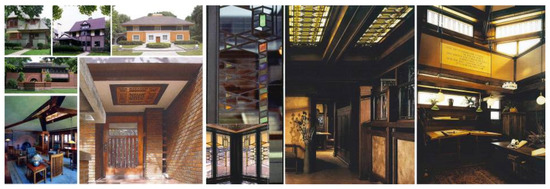
Figure 7.
Images of Wright’s Architecture in the Oak Park and River Forest districts. From sn to the top: Thomas H. Gale House (1892), Harry C. Goodrich House (1896), William H. Winslow House (1894); from below: Arthur B. Heurtley House (1902)—External and Internal View—Harry S. Adams House (1913); in the middle the colorful stained glass windows of Robie House’s dining room; on the right, the Wright’s home-office and drawing room in the Oak Park District (1889–1905).
5. Color, Lights and Movement in Times Square in New York
In the multiethnic and multicultural city of New York we can meet with many different locations: from the financial district in the south part of Manhattan island, boasting stunning buildings and densely populated places such as the New York Stock Exchange on Wall Street, Trinity Church, the Federal Reserve, Old Custom’s House and many others to the colorful Chinatown area with its thriving fruit and fish shops and colorful souvenir shops, a place similar to a lively and exotic market; from Greenwich Village, home to New York University and Washington Square Park, to high tech areas, with luxurious shopping streets, to the many green areas of city parks including the famous Central Park. In addition to this, there is Times Square: a large triangular square that extends from West 42nd Street to West 47th Street and is formed by the blocks between Sixth Avenue and Eighth Avenue and between West 40th Street and West 53rd Street, making it the westernmost part of Midtown Manhattan’s commercial area. The square and its surroundings, like a great commercial, have provided sitcom and television wallpapers and represent for millions of tourists visiting New York City a Must, a necessary and indispensable stop for a trip to the “Big Apple”. Times Square is well-known not only for the numerous Broadway theaters but especially for the large and numerous animated and digital billboards that color it incessantly, unequivocally justifying New York’s famous definition of “the city that never sleeps”.
The name Times Square, dating back to 1904 (formerly called Longacre Square) is due to the transfer of the New York Times newspaper right in this New York square. The newspaper publisher asked the mayor that the square was renamed in their honor and the mayor accepted. After 10 years, the newspaper headquarters were moved to another part of the city, and the Times Tower offices continued to be used by other companies. Not for long though, because the facade of the building began to become more and more an enormous billboard and today the building is completely empty for choice, as the 19 permanent advertising billboards guarantee building owners a much higher than what could be obtained by leasing the offices.
Over the years it has become an international icon and a miniature universe reflecting the obsessions, desires and priorities of a constantly evolving world. At the beginning of the First World War, Times Square was the center of the Theater District and began attracting a large number of visitors daily. This made the square an ideal place for installing billboards. In fact, in 1917, the installation of the first large electric screen came into being. Today, the square hosts many commercial, artistic, cultural and business activities, and is an authentic and ruthless place where art, life and trade collide in a ruthless swirling of colors. It has attractions such as ABC’s Times Square Studios, where Good Morning America is broadcasted live, stores like Levi’s Store (San Francisco, CA, USA), Toys “R” Us (Wayne, NJ, USA), Virgin Records (Los Angeles, CA, USA), Disney (Burbank, CA, USA), M & M’s (Hong Kong, China), but also restaurants like Ruby Foo’s (Chinese; New York, NY, USA), Bubba Gump Shrimp Company (Fish, Hong Kong, China), Hard Rock Café (Hong Kong, China), Mc Donalds (Des Plaines, IL, USA) and Carmine’s (Italian cuisine; New York, NY, USA) in addition to the aforementioned numerous theaters [7].
Over the last hundred years, the square, where the density of light-emitting dials (the signs of the square are officially called “spectaculars”) is comparable to that of Las Vegas, has become an outdoor lab for new ways of communicating and publicizing. Bright signage and futuristic animations blend into an exceptional urban spectacle consisting of a continuous sequence of lights, colors and moving images with remarkable visual impact.
Just think of NASDAQ’s seven-story signboard (opened in January 2000, it cost $37 million and is 36.6 m high. The NASDAQ pays more than two million dollars a year to rent space for the sign), placed close to NASDAQ MarketSite at Times Square 4 at the intersection with 43rd Street. General Electric rented its famous Panasonic Astro Vision screen through its NBC Universal division until October 2006, when the News Corporation took over and began using it to broadcast Fox News Channel. Testimony of Times Square’s unceasing dynamism is the latest news regarding the installation of a giant Android billboard consisting of a 24 million pixel LCD screen worth $2.5 million for a month of exposure. La gigantesca pubblicità di Android è anche interattiva. Le persone possono salire su una piattaforma e giocare ad alcuni giochi usando i loro avatar alti 6 metri creati tramite il sito o l’app di Androidify (Figure 8).
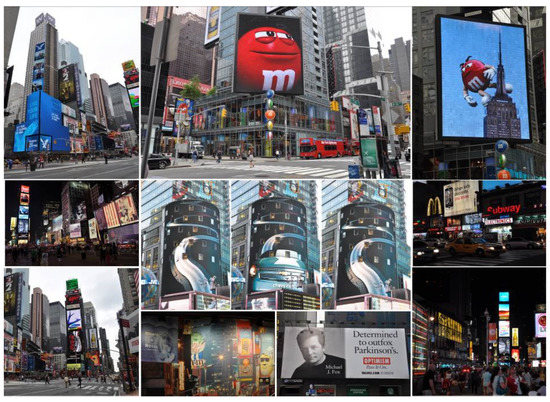
Figure 8.
Some images of Times Square in New York. In the center NASDAQ curved sign.
6. The Freedom Trail and Boston’s Historic Buildings
Boston is the smallest of the big cities in America. It does not count more than half a million inhabitants that become three and a half, including the urban area of Greater Boston. It is the historic city of excellence in the United States, having been the scene of the most important events of American independence. Boston Massacre, Boston Tea Party and Battle of Bunker Hill marked all significant milestones in the struggle for independence. Indeed, it was precisely here that the revolutionary movement came to life, initially triggered by the demands imposed by London. The city is a perfect blend of ancient and modern houses where red brick houses, tree-lined avenues, historic buildings, and spacious parks blend into shopping malls and mirror towers. The Freedom Trail (the line is made up of bricks or directly painted, both on the walls and on the sidewalk) is a path through the story signaled by a continuous red line extending for nearly six miles along the Boston pedestrian streets leading to 16 historic sites. Among the stages of the tour are the majestic “State House” (the Massachusetts State House is the home of the Massachusetts State Legislative Assembly as well as the headquarters of the State Governor. It is located in Boston, in the central district of Beacon Hill), the last home of patriot Samuel Adams, the Old Corner Bookstore, the Old South Meetinghouse and the Old State House, former headquarters of British governors at the time of the “Bay Colony” (the Old State House is a historic Boston building in Massachusetts, located at the intersection between Washington Street and State Street. Built in 1713, it was home to the Massachusetts Legislative Assembly until 1798. It is the oldest building in the city still in existence) [8,9].
Other characteristic shades are found in the brownstones district, the typical brown-stone residences, immediately recognizable thanks to brick sidewalks, gas lamps, wrought iron gates, hidden gardens and violet tinted glasses (Figure 9).
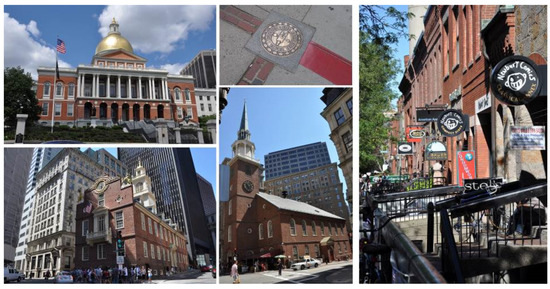
Figure 9.
Some images of Boston’s Old Town: Left on the Freedom Trail; to the right a glimpse of the brownstones neighborhood.
Conflicts of Interest
The images reproduced are not subject to third party licenses or copyright as they are the property of the author of the proceedings, with the exception of figures n.2 (http://phillipadams.com/), n.4 (https://www.muralarts.org/artworks/a-place-to-call-home/e) n.5 (https://www.muralarts.org/artworks/philly-painting/)
References
- Moeller, G.M., Jr. AIA Guide to the Architecture of Washington, D.C.; The Johns Hopkins University Press: Baltimore, ML, USA, 2006. [Google Scholar]
- Heinz, T.A. Frank Lloyd Wrigh’s Stained Glass & Lightscreens; Gibbs Smith, Publisher: Layton, Utah, 2000. [Google Scholar]
- Cannon, P.F. Hometown Architect: The Complete Buildings of Frank Lloyd Wright in Oak Park and River Forest, Illinois; Pomegranate Communications, Inc.: Portland, OR, USA, 2006. [Google Scholar]
- Abernathy, A. The Oak Park Home and Studio of Frank Llyod Wright; Frank Lloyd Wright Preservation Trust: Oak Park, IL, USA, 2010. [Google Scholar]
- Goldberger, P. Frank Lloyd Wright’s Robie House; (Introduction); Frank Lloyd Wright Preservation Trust: Oak Park, IL, USA, 2010. [Google Scholar]
- Hoffmann, D. Frank Lloyd Wright’s Robie House: The Illustrated Story of an Architectural Masterpiece; Dover Publications, Inc.: New York, NY, USA, 1984. [Google Scholar]
- White, N.; Willensky, E.; Leadon, F. AIA Guide to New York City; Oxford University Press: New York, NY, USA, 2010. [Google Scholar]
- Southworth, S.; Southworth, M. AIA Guide to Boston; GPP: Guilford, UK, 2008. [Google Scholar]
- Jones, S.; Malone, T. Freedom Trail Guide; Freedom Trail Foundation: Boston, MA, USA, 2009. [Google Scholar]
© 2017 by the author. Licensee MDPI, Basel, Switzerland. This article is an open access article distributed under the terms and conditions of the Creative Commons Attribution (CC BY) license (https://creativecommons.org/licenses/by/4.0/).